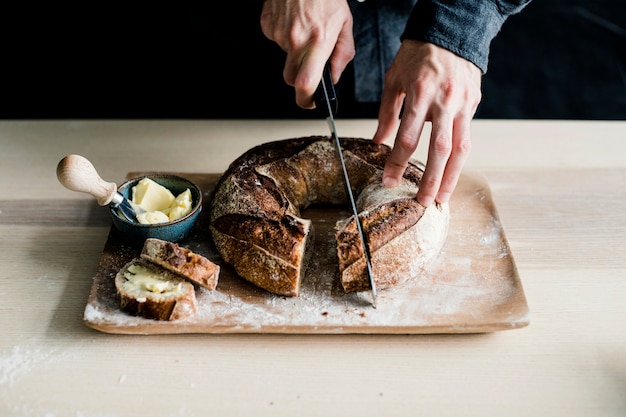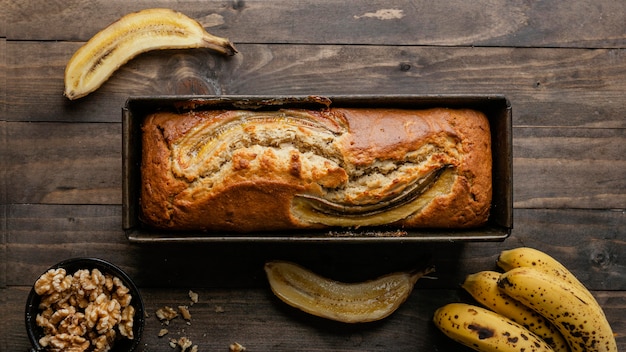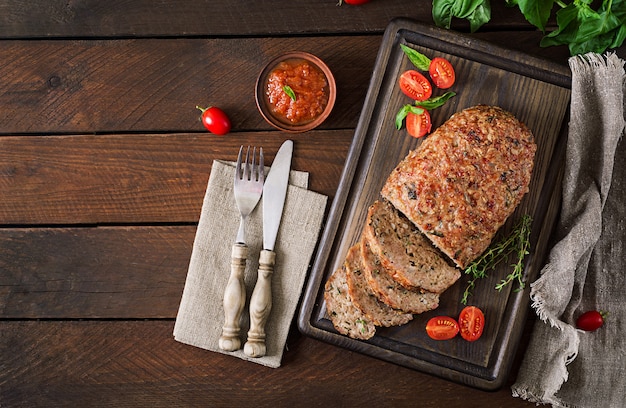Ever stared at a glorious 2lb lump of meatloaf, oven preheated to 350 degrees, and wondered just how long to bake it? That, my friend, is a question I've pondered myself, countless times. From the occasional culinary disaster to my grandma's time-tested wisdom, I've learned a thing or two about meatloaf. Let's embark on this tasty journey together, shall we?
(Part 1) The Meatloaf's First Impression: Getting to Know the Beast

Before we dive into the specifics of cooking time, let's take a moment to appreciate the star of the show: our 2lb meatloaf. It's a culinary beast, and understanding its composition is crucial to a successful outcome.
Understanding the Ingredients: A Culinary Symphony
My grandma always said, "A good meatloaf is like a symphony – every ingredient plays its part." And she was right! This isn't just a lump of meat; it's a carefully crafted blend of flavours and textures. Think of it like this:
- The Meat: This is the foundation. Traditionally, it's a mix of ground beef and pork, but don't be afraid to explore other options! Ground lamb, veal, even a touch of chorizo for a spicy kick – the possibilities are endless. Just make sure you're using good quality meat, as it'll make a world of difference in the final taste.
- The Binder: Eggs and breadcrumbs are the classic duo, holding everything together and adding structure. The eggs add moisture and richness, while breadcrumbs soak up excess liquid and provide a bit of texture.
- The Moisturiser: Milk or even a bit of stock is the secret weapon for a tender, juicy meatloaf. It helps keep the meatloaf moist and prevents it from drying out during cooking.
- The Flavour Bomb: Here's where the magic really happens! Herbs and spices, like onion powder, garlic powder, parsley, even a dash of cayenne for a little heat, bring the symphony to life. Feel free to experiment with your favourite flavour combinations – that's the beauty of cooking!
- The Extras: For an added nutritional punch and texture, some people like to incorporate chopped vegetables like onions, carrots, or celery. They add a subtle sweetness and heartiness to the mix.
Shape Up or Ship Out: The Meatloaf's Makeover
Now that you've got your meatloaf mixture ready, it's time to get it into shape.
- The Loaf Pan: You'll need a loaf pan, preferably a deeper one, to bake your meatloaf in. A deep pan allows for even cooking and helps prevent the meatloaf from spreading too much.
- The Shaping: Gently press the mixture into the loaf pan, leaving a little space at the top for the meat to rise. Don't pack it too tightly, as this can result in a dry and dense meatloaf.
- The Glaze: To give your meatloaf that gorgeous golden-brown colour, you need a glaze. Ketchup, barbecue sauce, honey and mustard - you name it! Experiment and find what works best for you. A glaze not only adds visual appeal but also helps to create a flavorful crust.
(Part 2) The Big Bake: Navigating the Oven's Domain

Alright, our meatloaf is prepped and ready to go. Now, we step into the oven's domain. It's like a culinary playground, and we need to know how to play it right.
The Oven Temperature: Finding the Sweet Spot
350 degrees fahrenheit is a great starting point. It's a reliable temperature that ensures even cooking without burning the outside. It allows the meatloaf to cook thoroughly without drying out.
Cooking Time: The Great Meatloaf Mystery
This is where things get a bit tricky. The cooking time for a 2lb meatloaf at 350 degrees isn't set in stone. It's like a culinary jigsaw puzzle, with several factors influencing the final bake time.
Factors Influencing Cooking Time: A Culinary Jigsaw Puzzle
These are the key pieces that impact the baking time:
- The Meat: Leaner meat, like ground turkey, will cook faster than fattier meat like ground beef. Fat slows down the cooking process, so keep that in mind.
- The Size: A smaller meatloaf will bake quicker than a larger one. It's simple physics – the bigger the loaf, the longer it takes to cook through.
- The Shape: A more evenly shaped meatloaf will cook more evenly than one with odd curves or bulges. A uniform shape allows heat to distribute evenly throughout the loaf.
- Your Oven: Ovens vary in their heat output. Some run hotter than others, so you might need to adjust your cooking time based on your oven's quirks.
- The Pan: A dark-colored pan will absorb heat and cook faster than a light-colored one. The material of your pan can also play a role – a cast iron pan will retain heat better than a glass pan.
(Part 3) The Meatloaf's Inner Sanctum: Testing for Doneness

The meatloaf is baking away, but how do we know when it's reached peak perfection? We need to delve into its inner sanctum to check for doneness.
The meat thermometer: A Culinary Hero
My go-to tool for checking meatloaf doneness is a trusty meat thermometer. It's the most accurate way to ensure the inside is cooked through without overdoing it. It eliminates guesswork and gives you peace of mind.
The Temperature Target: Reaching the Finish Line
For a safe and delicious meatloaf, aim for an internal temperature of 160 degrees Fahrenheit (71 degrees Celsius). This ensures the meat is fully cooked and reaches a delightful level of tenderness.
Alternative doneness tests: A Culinary Toolkit
Not everyone has a meat thermometer handy. Here are a few alternatives to check for doneness:
- The Finger Test: Gently press the center of the meatloaf. If it feels firm and springy, it's likely done. If it's still soft, it needs more time. This method is less precise than a thermometer but can give you a general idea of the doneness.
- The Visual Check: The meatloaf should be browned on the outside and no longer pink inside. However, this method can be unreliable, as the meatloaf might appear cooked on the outside but still be raw in the center.
(Part 4) The Meatloaf's Resting Time: Giving It a Moment to Breathe
The meatloaf is cooked, and the temptation to slice into it right away is strong. But hold your horses! It needs a bit of a rest before we can enjoy its deliciousness.
Why Rest? A Culinary Balancing Act
Imagine the meatloaf has just finished a strenuous workout in the oven. It needs a chance to recover, reabsorb its juices, and relax before we carve it up. This resting period is crucial for achieving a moist and flavorful final product.
The Resting Time: A Little Patience Goes a Long Way
Let the meatloaf rest for at least 10-15 minutes before slicing. During this time, the juices redistribute, preventing them from running out when you cut into the loaf. The result? A moist and flavorful slice that will make your taste buds sing.
(Part 5) The Meatloaf's Debut: Unveiling the Culinary Star
The moment of truth: time to unveil the meatloaf's deliciousness.
Slicing the Meatloaf: A Culinary Art Form
This is your chance to show off your knife skills. Slice the meatloaf into thick slices, or even wedges, depending on your preference. Remember to slice it against the grain, which will make it easier to chew and prevent the meat from becoming tough.
Serving the Meatloaf: A Culinary Symphony
Time to get creative! Serve your meatloaf alongside mashed potatoes, gravy, roasted vegetables, or even a simple green salad. You can also try pairing it with a light and refreshing fruit salad for a contrast of textures and flavors.
(Part 6) Meatloaf Mishaps: Troubleshooting the Culinary Chaos
Let's be real – even the most experienced cooks have their moments. What happens if your meatloaf doesn't turn out exactly as planned? Don't despair! We can troubleshoot these culinary mishaps together.
The Dry Meatloaf: Restoring Moisture
A dry meatloaf is a common issue, but it doesn't have to be a culinary disaster. Here are a few tips to rescue it:
- Add a Sauce: Top it with gravy, ketchup, or barbecue sauce. These sauces not only add moisture but also provide extra flavor.
- Slice Thinly: If you're serving it cold, thin slices will help to disguise any dryness. Thin slices are also easier to chew, making the meatloaf more palatable.
The Undercooked meatloaf: A Second Chance
An undercooked meatloaf isn't the end of the world. You can give it a second chance to reach its full potential:
- Back to the Oven: Pop it back in the oven for a few more minutes, checking the temperature regularly with a meat thermometer. Be sure to check the temperature frequently to avoid overcooking the meatloaf.
- The Pan Method: Add a bit of broth to the bottom of the pan, cover it with foil, and cook it a little longer on the stovetop. This creates a steamy environment that helps to cook the meatloaf through and adds moisture.
The Overcooked Meatloaf: A Culinary Lesson Learned
Overcooked meatloaf is less of a disaster and more of a learning experience. It might be a bit dry, but you can still make it work.
- Slice Thickly: Try to hide the dryness by serving thicker slices. This also helps to retain moisture and prevent the meatloaf from falling apart.
- Add Some Moisture: Serve it with a generous amount of gravy, mashed potatoes, or even a creamy sauce. These toppings help to create a more moist and flavorful experience.
(Part 7) meatloaf variations: Exploring Culinary Frontiers
You've mastered the classic meatloaf, but don't stop there! The world of meatloaf is full of exciting variations waiting to be explored.
The Italian Meatloaf: A Taste of Tuscany
This meatloaf is infused with the flavors of Italy, featuring sun-dried tomatoes, black olives, and aromatic herbs like basil and oregano. It's typically served with a rich and flavorful tomato sauce. The combination of earthy flavors, salty olives, and sweet tomatoes creates a truly authentic Italian experience.
The Spicy Meatloaf: A Kick of Heat
For those who love a bit of fire in their food, this meatloaf utilizes chorizo sausage and jalapenos for a fiery kick. The chorizo adds a smoky and savory depth, while the jalapenos provide a refreshing burst of heat. This meatloaf is perfect for those who enjoy a little spice in their life.
The Southwestern Meatloaf: A Tex-Mex Delight
This meatloaf gets a southwest twist with the addition of corn, black beans, and spices like cumin and chili powder. The corn and black beans add a hearty texture and a subtle sweetness, while the cumin and chili powder bring a warm and earthy flavor. It's often served with a side of salsa and guacamole for a truly authentic Southwestern experience.
(Part 8) meatloaf leftovers: Transforming Culinary Treasures
Let's be honest: meatloaf is often a "make it once, eat it for days" kind of meal. But don't despair, those leftovers can be transformed into delicious new dishes.
Meatloaf Sandwiches: A Quick and Easy Treat
Slice up the leftover meatloaf, toast some bread, and you've got a hearty and satisfying sandwich. Add some mustard, mayonnaise, or even a bit of cheese for extra flavor. A meatloaf sandwich is a perfect quick lunch or snack, and it's a great way to use up leftovers.
Meatloaf Salad: A Lighter Option
Dice up the leftover meatloaf and add it to a salad with some fresh vegetables, a light dressing, and a sprinkle of cheese. It's a great way to use up leftovers and get a healthy meal on the table. The meatloaf adds protein and heartiness to the salad, making it a satisfying and satisfying meal.
Meatloaf Soup: A Warm and Comforting Meal
Chop the meatloaf into small pieces and add it to a pot of your favorite soup. It adds a hearty and flavorful texture to any soup, especially tomato soup or chili. The meatloaf adds a savory depth and texture to the soup, making it more filling and satisfying.
FAQs: Answering Your Meatloaf Questions
You've got questions, and I've got answers. Here are a few commonly asked questions about meatloaf:
1. Can I Freeze Meatloaf?
Absolutely! You can freeze cooked meatloaf for up to 3 months. Wrap it tightly in plastic wrap or aluminum foil and then place it in a freezer-safe bag. This allows you to enjoy delicious meatloaf even when you don't have time to cook.
2. How Do I Reheat Meatloaf?
There are a few ways to reheat meatloaf:
- Oven: Preheat the oven to 350 degrees. Wrap the meatloaf in foil and bake for 20-30 minutes. This method ensures that the meatloaf is heated through evenly and retains its moisture.
- Microwave: Cover the meatloaf with a damp paper towel and microwave on high for 1-2 minutes, depending on the size of the meatloaf. This method is quick and convenient but can sometimes result in a dry meatloaf.
- Stovetop: Heat a skillet over medium heat and add a bit of oil. Place the meatloaf in the skillet and cook for 5-10 minutes, turning occasionally, until heated through. This method gives the meatloaf a crispy crust and adds a bit of flavor.
3. What Should I Serve with Meatloaf?
The possibilities are endless!
- Starchy Sides: Mashed potatoes, mashed sweet potatoes, rice, or even pasta. These provide a comforting and filling base for the meatloaf.
- Veggies: Roasted vegetables, green beans, peas, or even a simple salad. These add a touch of freshness and color to the plate.
- Sauce: Gravy, ketchup, barbecue sauce, or even a creamy mushroom sauce. Sauces add moisture and flavor to the meatloaf, making it even more delicious.
4. What Kind of Breadcrumbs Should I Use?
You can use any type of breadcrumbs you like. I prefer plain breadcrumbs, but you can also use seasoned breadcrumbs or even panko breadcrumbs for a crispier crust. Experiment with different types of breadcrumbs to find what you prefer.
5. Can I Make Meatloaf Ahead of Time?
You bet! You can assemble the meatloaf and refrigerate it for up to 24 hours before baking. This allows the flavors to meld together and creates a more flavorful meatloaf. It's a great option for busy schedules or when you want to prepare a meal ahead of time.
There you have it, folks! Everything you need to know about cooking a 2lb meatloaf at 350 degrees. Now get out there and create a culinary masterpiece! Happy cooking!
Everyone is watching

Prime Rib Roast Cooking Time Chart: Per Pound Guide
Cooking TipsPrime rib roast. Just the name conjures images of lavish dinners, crackling fires, and hearty laughter. It’s ...

How Long to Bake Potatoes in the Oven (Perfect Every Time)
Cooking TipsBaked potatoes are a staple in my kitchen. They're incredibly versatile, delicious, and surprisingly easy to m...

Perfect Rice Every Time: The Ultimate Guide to Cooking Rice
Cooking TipsAs a self-proclaimed foodie, I've always been a bit obsessed with rice. It's the foundation of countless cuisi...

The Ultimate Guide to Cooking Asparagus: Tips, Techniques, and Recipes
Cooking TipsAsparagus. The mere mention of this spring delicacy conjures up images of vibrant green spears, crisp and burs...

Ultimate Guide to Cooking the Perfect Thanksgiving Turkey
Cooking TipsThanksgiving. Just the word conjures up images of overflowing tables laden with delicious food, the scent of r...
